[Editor’s Note: The following is an interview I conducted with Jim Stumm, the editor of Rayo’s first book, “Vonu: The Search for Personal Freedom,” and publisher of LIVING FREE, a libertarian newsletter that has been running since 1979. He also met Rayo back in 1971. He’ll provide more personal details below.
Of course, an audio/video interview would have been preferable, but Jim is now an older man and hard of hearing. His responses will be marked “Jim” and my comments will be [in brackets]. For articles/books he references, I’ll provide links. Please enjoy and consider giving it a share. Thanks! -Shane]
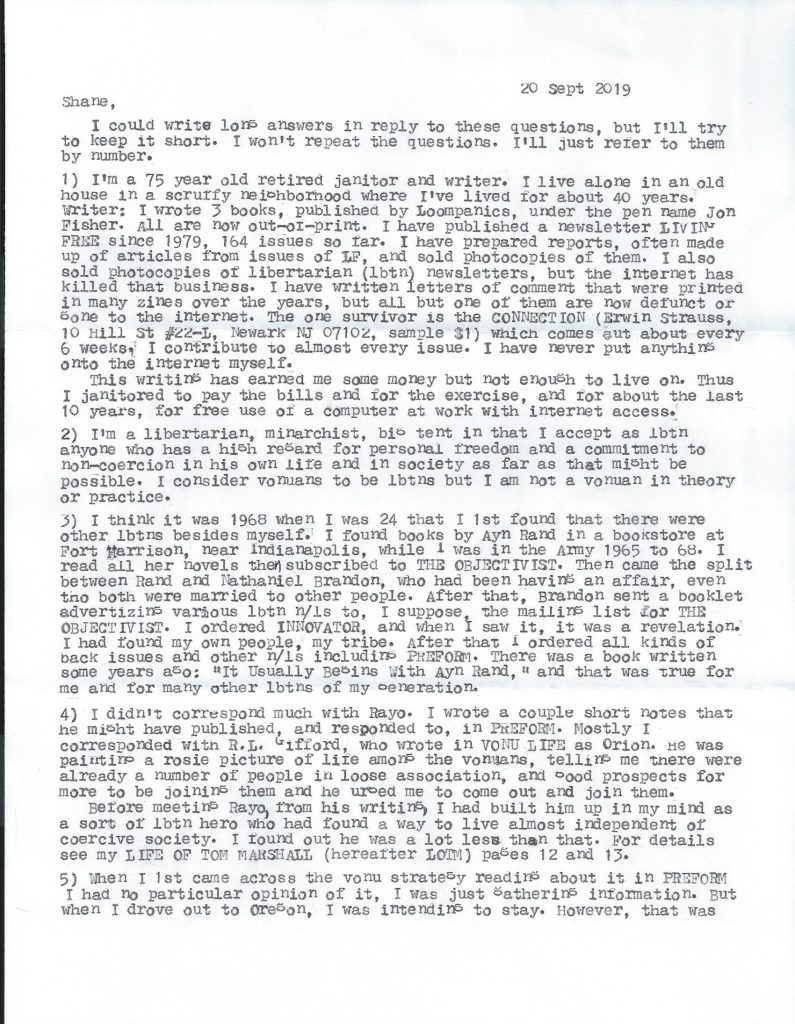
1/4 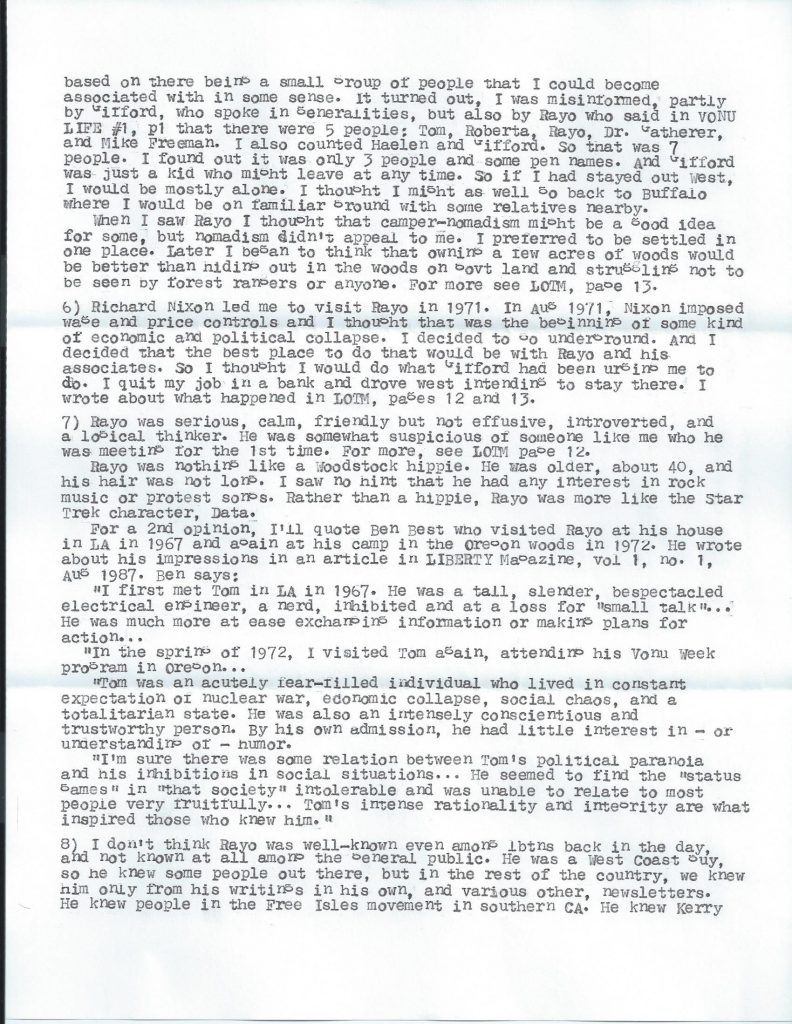
2/4 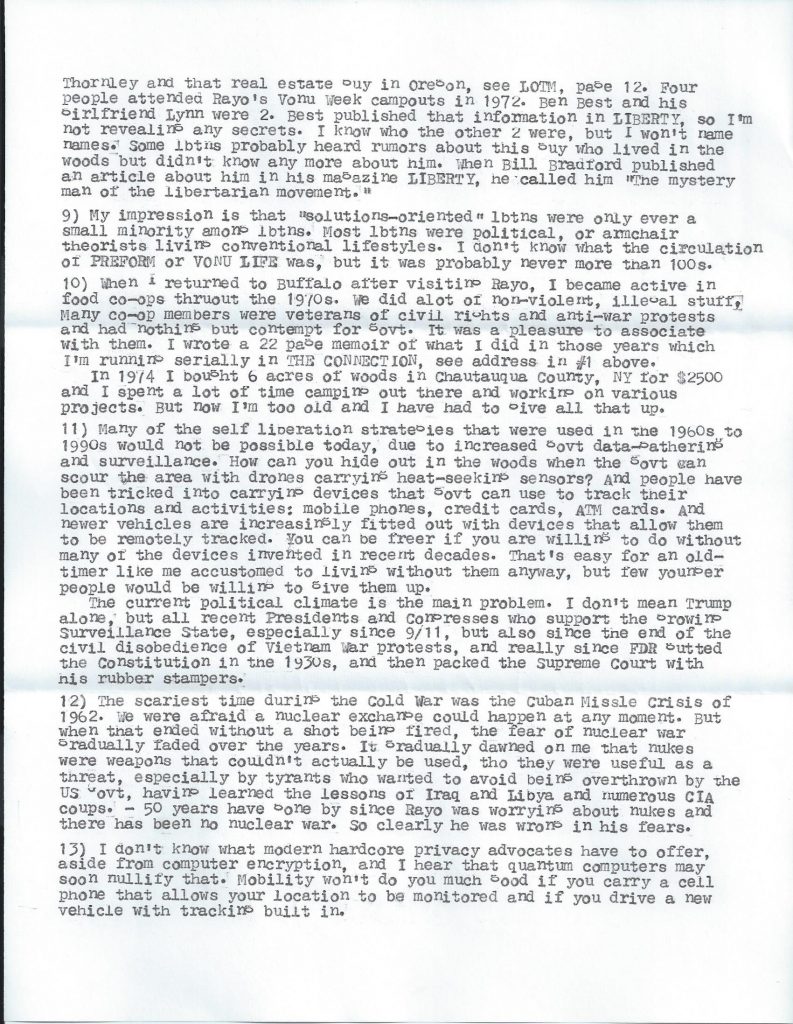
3/4 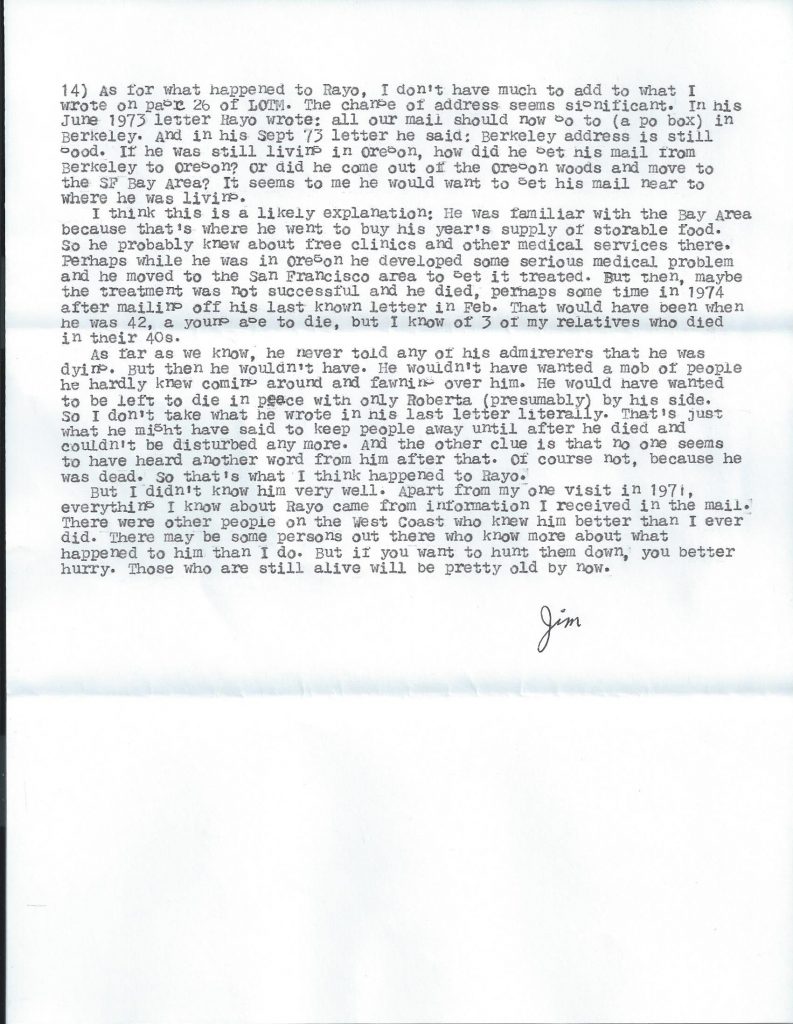
4/4
1. First off, would you mind introducing yourself? Who are you and what do you do?
Jim: I’m a 75-year old retired janitor and writer. I live alone in an old house in a scruffy neighborhood where I’ve lived for about 40 years. Writer: I wrote 3 books, published by Loompanics, under the pen name Jon Fisher. All are now out-of-print. I have published a newsletter, LIVING FREE, since 1979, 164 issues so far. I have prepared reports, often made up of articles from issues of LF, and sold photocopies of them. I also sold photocopies of libertarian (lbtn) newsletters, but the Internet has killed that business [sorry, Jim! Ha.]. I have written letters of comment that were printed in many zines over the years, but all but one of them are now defunct or gone to the Internet. The one survivor is THE CONNECTION (Erwin Strauss, 10 Hill St. #22-L, Newark, NJ 07102, sample $1) which comes out about every 6 weeks. I contribute to almost every issue. I have never put anything onto the Internet myself.
This writing has earned me some money but not enough to live on. Thus, I janitored to pay the bills and for the exercise, and for about the last 10 years, for free use of a computer at work with Internet access.
[I subscribed to THE CONNECTION and submitted an introductory piece that should be included in the next issue. It’s cheap, all of you should subscribe, or at least get the sample issue for $1.]
2. Where do you align philosophically/ideologically?
Jim: I’m a libertarian, minarchist, big tent in that I accept as lbtn anyone who has a high regard for personal freedom and a commitment to non-coercion in his own life and in society as far as that might be possible. I consider vonuans to be lbtns but I am not a vonuan in theory or practice.
3. When did you first come across the libertarian community and how did it happen? How old were you?
Jim: I think it was 1968 when I was 24 that I first found that there were other lbtns besides myself. I found books by Ayn Rand in a bookstore at For Harrison, near Indianapolis, while I was in the Army 1965 to 1968. I read all her novels then subscribed to THE OBJECTIVIST. Then came the split between Rand and Nathaniel Brandon, who had been having an affair, even though both were married to other people. After that, Brandon sent a booklet advertising various lbtn newsletters to, I suppose, the mailing list for THE OBJECTIVIST. I ordered INNOVATOR, and when I saw it, it was a revelation. I had found my own people, my tribe. After that, I ordered all kinds of back issues and other newsletters including PREFORM. There was a book written some years ago: “It Usually Begins With Ayn Rand,” and that was true for me and many other lbtns of my generation.
4. How much correspondence did you have with Rayo before meeting him? What was your impression of him then?
Jim: I didn’t correspond much with Rayo. I wrote a couple short notes that he might have published, and responded to, in PREFORM. Mostly, I corresponded with R.L. Gifford, who wrote in VONU LIFE as Orion. He was painting a rosy picture of life among the vonuans, telling me there were already a number of people in loose association, and good prospects for more to be joining them and he urged me to come out and join them.
Before meeting Rayo, from his writing, I had built him up in my mind as a sort of lbtn hero who had found a way to live almost independent of coercive society. I found out he was a lot less than that. For details, see my LIFE OF TOM MARSHALL (hereafter LOTM) pages 12 and 13.
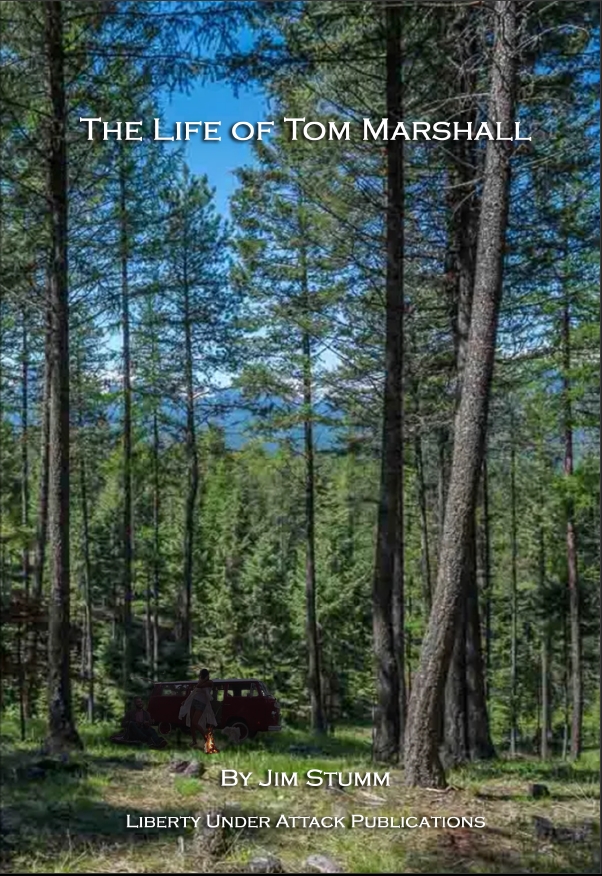
5. What did you think of vonu as a strategy when you first came across it?
Jim: When I first came across the vonu strategy reading about it in PREFORM, I had no particular opinion of it. I was just gathering information. But when I drove out to Oregon, I was intending to stay. However, that was based on there being a small group of people that I could become associated with in some sense. It turned out, I was misinformed, partly by Gifford, who spoke in generalities, but also by Rayo who said in VONU LIFE #1, p. 1 that there were 5 people: Tom, Roberta, Rayo, Dr. Gatherer, and Mike Freeman. I also counted Haelen and Gifford. So that was 7 people. I found out it was only 3 people and some pen names. And Gifford was just a kid who might leave at any time. So if I had stayed out West, I would be mostly alone. I thought I might as well go back to Buffalo where I would be on familiar ground with some relatives nearby.
When I saw Rayo, I thought that camper nomadism might be a good idea for some, but nomadism didn’t appeal to me. I preferred to be settled in one place. Later, I began to think that owning a few acres of woods would be better than hiding out in the woods on gov’t land and struggling not to be seen by forest rangers or anyone. For more, see LOTM, page 13.
6. What made you go visit Rayo in 1971?
Jim: Richard Nixon led me to visit Rayo in 1971. In Aug. 1971, Nixon imposed wage and price controls and I thought that was the beginning of some kind of economic and political collapse. I decided to be underground. And I decided that the best place to do that would be with Rayo and his associates. So I thought I would do what Gifford had been urging me to do. I quit my job in a bank and drove west intending to stay there. I wrote about what happened in LOTM, pages 12 and 13.
7. Obviously, me and my listeners/readers want to know everything about Rayo – when you met him in person, what was he like? Characteristics, stories, etc.? Was he serious all the time, or a jokester? Introverted or extroverted?
My co-host’s comment: “I just want more of a mental image than a Woodstock hippie with a backpack.”
Jim: Rayo was serious, calm, friendly, but not effusive, introverted, and a logical thinker. He was somewhat suspicious of someone like me who he was meeting for the first time. For more, see LOTM page 12.
Rayo was nothing like a Woodstock hippie. He was older, about 40, and his hair was not long. I saw no hint that he had any interest in rock music or protest songs. Rather than a hippie, Rayo was more like the Star Trek character, Data.
For a second opinion, I’ll quote Ben Best who visited Rayo at his house in LA in 1967 and again at his camp in the Oregon woods in 1972. He wrote about his impressions in an article in LIBERTY MAGAZINE, vol. 1, no. 1, Aug. 1987. Ben says:
“I first met Tom in LA in 1967. He was a tall, slender, bespectacled electrical engineer, a nerd, inhibited and at a loss for ‘small talk’…He was much more at ease exchanging information or making plans for action…
“In the spring of 1972, I visited Tom again, attending his Vonu Week program in Oregon…
“Tom was an acutely fear-filled individual who lived in constant expectation of nuclear war, economic collapse, social chaos, and a totalitarian state. He was also an intensely conscientious and trustworthy person. By his own admission, he had little interest in – or understanding of – humor.
“I’m sure there was some relation between Tom’s political paranoia and his inhibitions in social situations…He seemed to find the ‘status symbols’ of ‘that society’ intolerable and was unable to relate to most people very fruitfully…Tom’s intense rationality and integrity are what inspired those who knew him.”
8. How “popular” or well-known was Rayo/Tom Marshall in his heyday?
Jim: I don’t think Rayo was well-known even among lbtns back in the day and not known at all among the general public. He was a West Coast guy, so he knew some people out there, but in the rest of the country, we only knew him from his writing in his own, and various other, newsletters. He knew people in the Free Isles movement in southern CA. He knew Kerry Thornley and that real estate guy in Oregon, see LOTM, page 12. Four people attended Rayo’s Vonu Week campouts in 1972. Ben Best and his girlfriend, Lynn, were two. Ben published that information in LIBERTY, so I’m not revealing any secrets. I know who the other two were, but I won’t name names. Some lbtns probably heard rumors about this guy who lived in the woods, but didn’t know any more about him. When Bill Bradford published an article about him in his magazine, LIBERTY, he called him “The mystery man of the libertarian movement.”
9. If you have any idea, how large was the solutions-oriented libertarian movement throughout the 1960’s and 70’s? Say, readers of VonuLife or the “new” Preform?
Jim: My impression is that “solutions-oriented” lbtns were only ever a small minority among lbtns. Most lbtns were political, or armchair theorists living conventional lifestyles. I don’t know what the circulation of PREFORM or VONU LIFE was, but it was probably never more than 100s.
[Oh, you don’t say? Man, things haven’t changed much, have they? I’d say that fact alone (the focus of libertarians for the past ~60 years) demonstrates the failed efficacy of the most common strategies — political crusading/”theoretical anarchy”. -Shane]
10. Did you pursue any vonu lifestyles? If so, could you tell us a bit about them? What did you do, positives, drawbacks, etc.?
Jim: When I returned to Buffalo after visiting Rayo, I became active in food co-ops throughout the 1970s. We did a lot of non-violent, illegal stuff. Many co-op members were veterans of civil rights and anti-war protests and had nothing but contempt for gov’t. It was a pleasure to associate with them. I wrote a 22-page memoir of what I did in those years which I’m running serially in THE CONNECTION, see address in #1 above.
In 1974, I bought 6 acres of woods in Chautauqua County, NY for $2,500 and I spent a lot of time camping out there and working on various projects. But now I’m too old and I have had to give all that up.
11. Compared to the 1960’s and 70’s (and, I suppose the 80’s, too), what’s your view on the pursuance of self-liberation today? Do you think it’s worthwhile? Easier or more difficult? And, what impact does the current political climate have on your answer?
Jim: Many of the self-liberation strategies that were used in the 1960s to 1990s would not be possible today, due to increased gov’t data-gathering and surveillance. How can you hide out in the woods when the gov’t can scour the area with drones carrying heat-seeking sensors? And people have been tricked into carrying devices that gov’t can use to track their locations and activities: mobile phones, credit cards, ATM cards. And newer vehicles are increasingly fitted out with devices that allow them to be remotely tracked. You can be freer if you are willing to do without many of the devices invented in recent decades. That’s easy for an old-timer like me accustomed to living without them anyway, but few younger people would be willing to give them up.
The current political climate is the main problem. I don’t mean Trump alone, but all recent Presidents and Congresses who support the growing Surveillance State, especially since 9/11, but also since the end of the civil disobedience of Vietnam War protests, and really since FDR gutted the Constitution in the 1930s, and then packed the Supreme Court with his rubber stampers.
12. Now, obviously, I wasn’t born until 1992, which means I missed the experience of the Cold War. Rayo was seriously concerned with the risk of nuclear attack at that time; he even thought the likelihood increased by 10% with each passing year. My question for you is this: you lived through that time – do you think his fears were rational? Irrational? Did you share similar concerns?
Jim: The scariest time during the Cold War was the Cuban Missile Crisis of 1962. We were afraid a nuclear exchange could happen at any moment. But when that ended without a shot being fired, the fear of nuclear war gradually faded over the years. It gradually dawned on me that nukes were weapons that couldn’t actually be used, though they were useful as a threat, especially by tyrants who wanted to avoid being overthrown by the US Gov’t, having learned the lessons of Iraq and Libya and numerous CIA coups. – 50 years have gone by since Rayo was worrying about nukes and there has been no nuclear war. So clearly he was wrong in his fears.
13. One of the comments I’ve received from hardcore privacy advocates (mainly crypto-anarchists) on Rayo is that he was truly a pioneer in the field of OPSEC. He talked about encrypted radio nets, he understood the utility of pseudonyms, he explicated the importance of mobility, and he understood that if there is no attribution to an action, punishment can’t come (thereby making him more invulnerable to those who would bring forth said punishment). I don’t really have a question here for you, but I suppose I’d like to get your thoughts on this if you have any.
Jim: I don’t know what modern hardcore privacy advocates have to offer, aside from computer encryption, and I hear that quantum computers may soon nullify that. Mobility won’t do you much good if you carry a cell phone that allows your location to be monitored and if you drive a new vehicle with tracking built in.
14. We’ll probably never know the answer to this question, but you are the individual most qualified to provide some speculation: what do you think happened to Rayo?
Jim: As for what happened to Rayo, I don’t have much to add to what I wrote on page 26 of LOTM. The change of address seems significant. In his June 1973 letter, Rayo wrote: “All our mail should now go to (a PO Box) in Berkeley.” And in his Sept. 1973 letter, he said: “Berkeley address is still good.” If he was living in Oregon, how did he get his mail from Berkeley to Oregon? Or did he come out of the Oregon woods and move to the SF Bay Area? It seems to me he would want to get his mail near to where he was living.
I think this is a likely explanation: He was familiar with the Bay Area because that’s where he went to buy his year’s supply of storable food. So he probably knew about free clinics and other medical services there. Perhaps while he was in Oregon, he developed some serious medical problem and he moved to the San Francisco area to get it treated. But then, maybe the treatment was not successful and he died, perhaps some time in 1974 after mailing off his last known letter in Feb. That would have been when he was 42, a young age to die, but I know of 3 of my relatives who died in their 40’s.
As far as we know, he never told any of his admirers that he was dying. But then, he wouldn’t have. He wouldn’t have wanted a mob of people he hardly knew coming around and fawning over him. He would have wanted to be left to die in peace with only Roberta (presumably) by his side. So I don’t take what he wrote in his last letter literally. That’s just what he might have said to keep people away until after he died and couldn’t be disturbed any more. And the other clue is that no one seems to have heard another word from him after that. Of course not, because he was dead. So that’s what I think happened to Rayo.
But I didn’t know him very well. Apart from my one visit in 1971, everything I know about Rayo came from information I received in the mail. There were other people on the West Coast who knew him better than I ever did. There may be some persons out there who know more about what happened to him than I do. But if you want to hunt them down, you better hurry. Those who are still alive will be pretty old by now.
-Jim
Check out Liberty Under Attack Publications for books, privacy tools, & apothecary items to aid you in your pursuit of self-liberation, or if you’re an author looking for a liberty-focused publisher!
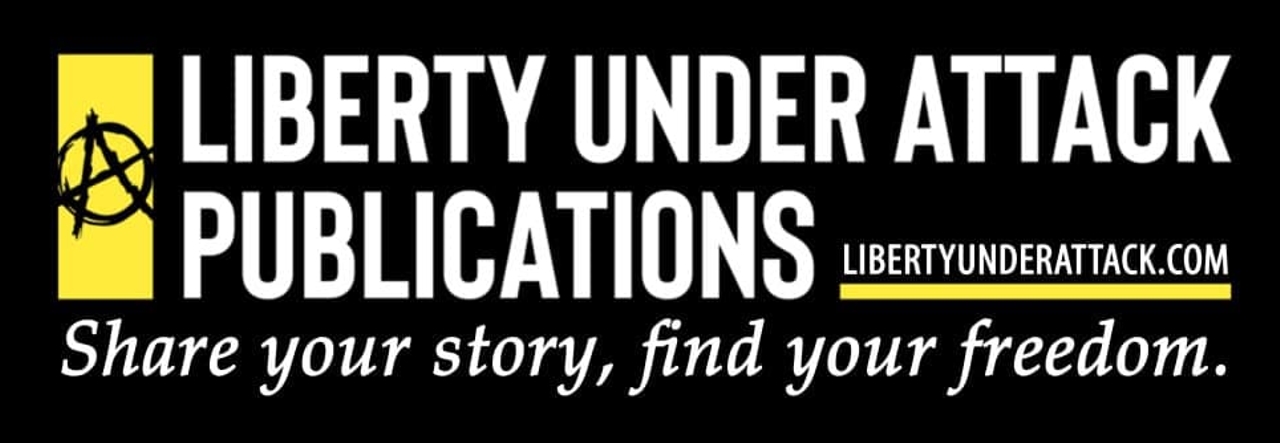
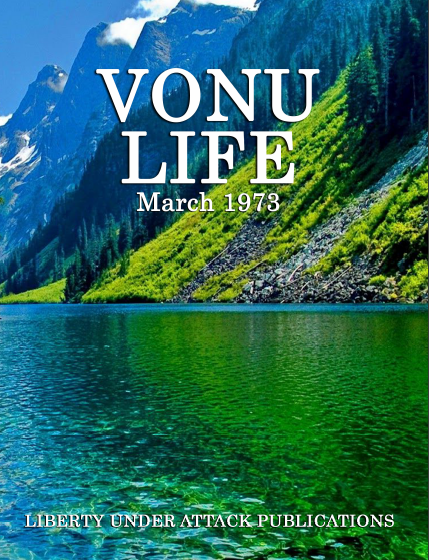

2 Replies to “An Interview with Jim Stumm: The Man Who Met Rayo”